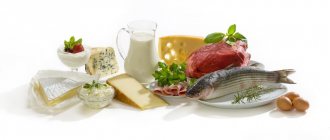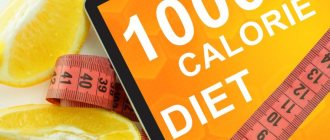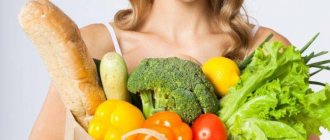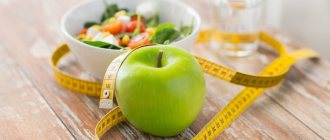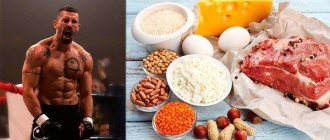The vast majority of people, in our fast-paced age, are increasingly thinking about the topic of proper nutrition. There are several important reasons for this. Firstly, proper nutrition allows you to feel cheerful and fresh, and secondly, it helps to maintain weight in a certain category.
Today we will look at a menu for 1300 calories per day. Looking ahead, it should be noted that this menu is perfect for both men and women, both for losing weight and maintaining weight.
1300 calorie meal
The minimum daily calorie intake for adults is 1200 calories. However, when doing physical labor or sports, this figure increases sharply and amounts to 1500 calories or more. Thus, a balanced menu of 1300 calories will be the golden mean.
The main condition is to find the right balance with kbju. It is the clear distribution of the main groups of elements that is the key to the success of any balanced diet.
Kbju is a generally accepted formulation of the main elements (calories, proteins, fats, carbohydrates) when compiling a pp menu.
Norm and formula
Balancing kbju is strictly individual and is developed directly for a specific person.
Factors influencing the calculation:
- Sex differences;
- Age category;
- Lifestyle at the time of counting;
- The goal, that is, what you are trying to achieve - losing weight, gaining weight or maintaining it;
- Human metabolism.
Next, the calculation formula is used. There is no strictly defined formula, so nutritionists use the most effective ones, based on the above characteristics.
We will use a formula that is generally accepted by many nutritionists from different countries.
Calculation formula for women:
9.99 x exact weight in kg + 6.25 x exact height in cm –4.92 x full age in years – 161
Calculation formula for men:
9.99 x exact weight in kg + 6.25 x exact height in cm – 4.92 x full height in years + 5
We get a strictly defined figure, these are the calories that you spend every day, even if you just lie on the couch and sometimes move your arm or leg.
Next, you should multiply the resulting amount by KA (activity coefficient).
The coefficient directly depends on lifestyle:
- Absolutely passive image or permanently sedentary work, no sports, KA is 1.2;
- Light physical activity twice a week, KA is 1.4;
- If you are on the move or visit the gym 3-5 times, then KA is 1.46;
- Full-time classes in the gym 5 times a week – 1.55;
- Daily sports activities – 1.63;
- Exercising twice a day, throughout the week – 1.72;
- Work associated with constant physical activity, or playing sports with full effort twice a day – 1.9.
For example, let’s take my indicator and calculate the norm together:
1337 x 1.4 = 1872 kilocalories (kcal).
This is exactly the amount of food my body needs to constantly maintain weight.
To gradually lose weight, you need to subtract ten percent, and to gain weight, add it accordingly.
1872 – 10% = 1685 kcal. For weight loss.
1872 + 10% = 2059 kcal. For recruitment.
You can increase the percentage for faster results. However, in this case, the body will be subject to severe stress, and this can lead to undesirable consequences.
It is extremely difficult to absolutely maintain these numbers, so they resort to a “calorie corridor.” The minimum limit of which drops to – 250 kcal, and the maximum rises to + 100 kcal.
Calculate your ideal weight
How to calculate the KBJU of ready-made dishes
To calculate the KBJU of ready-made dishes (soup, salad, porridge), you need to know the calorie content of each ingredient from which the dish is prepared.
The product packaging indicates the amount of substances per 100 g. Before you start cooking, you need to weigh the ingredients, calculate the exact parameters for each of them, and summarize the resulting numbers. After that preparation, you need to calculate the KBJU. To do this, the product is weighed.
The formula for calculating the energy value per 100 g of a finished dish is as follows:
Divide the calorie content of all ingredients used by the weight of the finished dish and multiply by 100.
Next, you need to separately calculate the number of BZHU. To do this, the amount of the element in the ingredients is divided by the weight of the finished product and multiplied by 100.
1300 calorie diets with recipes
A simple menu for a given amount of calories, very comfortable and convenient, you won’t have to go hungry.
The advantages include:
- Accelerated metabolism;
- Improvement of skin;
- The condition of hair and nails noticeably improves;
- Increased tone, improved well-being;
- The appearance of lightness.
Minuses:
- Feeling hungry in the first days;
- Fast fatiguability;
- Dizziness;
- Fainting.
With prolonged use of a diet for such a number of calories, there is a decline in efficiency, as well as a decrease in metabolism.
Weekly menu with simple ingredients
All recipes are very simple, prepared from available products.
Day 1 - 1314 kcal. (BZHU - 78/31/180)
7.30 – 220 g of oatmeal, prepared with low-fat milk, with the addition of 60 g of fresh berries. Walnut - 10 g. Black coffee or unsweetened tea.
11.30 – green apple – 170 g.
14.30 – 120 g buckwheat porridge with milk 1.5% fat. Salad-250 g: cucumber, tomato, green. peas, carrots, egg, yogurt.
16.30 – banana – 120 g. Herbal tea.
18.30 – chicken breast salad with vegetables (tomato, cucumber, herbs), dressed with yogurt. Chicory with milk.
19.30 — A glass of kefir with one slice.
Day 2 - 1301 Kcal (BJU -110/32/138)

7.30 – 210 g low-fat cottage cheese – 200 g, banana – 100 g. Black coffee or tea without sugar.
11.30 – orange – 130 g, raw carrots – 150 g.
14.30 – boiled brown rice – 120 g, steamed salmon small portion, 250 g, seasoned vegetable salad 1 tsp. butter - 200 g.
16.30 – 30 g of black bread with low-fat cottage cheese and one tomato. Tea.
18.30 – small portion of omelette with vegetables, chicory with milk.
19.30 - green apple.
Day 3 - 1305 Kcal (BZHU-100/43/133)
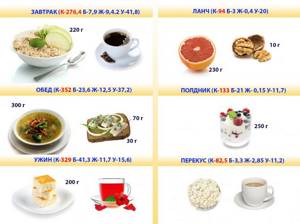
7.30 –220 g oatmeal cooked with low-fat milk. Add one grated apple and one teaspoon of cinnamon to the porridge. Coffee.
11.30 – half a grapefruit, walnut – 10 g.
14.30 – vegetable soup, one serving. 30 g rye bread with herring.
16.30 – yogurt with berries (can be fresh frozen).
18.30 – cottage cheese casserole – 200 g without sugar. To prepare, you need to take low-fat cottage cheese, kefir, egg, and oat bran. Bake like a regular casserole. Tea.
Just before bed – chicory with milk + slice.
Day 4 - 1300 Kcal (BJU - 109/20/170)

7.30 – 80 g of dry muesli diluted with kefir (200 ml). Half a grapefruit, black coffee or tea.
11.30 – green apple – 180 g.
14.30 – chicken breast soup: chicken fillet – 80 g, potatoes – 100 g, buckwheat – 25 g, green peas – 50 g, herbs – 15 g. One slice.
16.30 – 50 g of black bread with low-fat cottage cheese and one tomato.
18.30 – steamed white tilapia fish 190 g. Vegetable salad: tomato – 100 g, cucumber – 100 g, green peas – 50 g, radishes – 50 g, carrots – 50 g, greens – 15 g, season with yogurt – 60 ml.
Before bed - herbal tea. Do not add milk or sugar.
Day 5 – 1301 Kcal (BJU – 90/38/145)
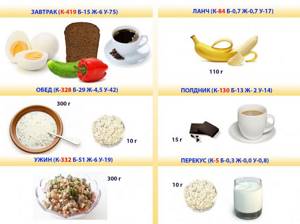
7.30 – 30 g of black bread, two boiled eggs, cucumber – 80 g, bell pepper – 145 g. Black coffee or tea, do not add sugar.
11.30 – banana – 110 g.
14.30 – buckwheat porridge with milk (without butter and sugar), you can add sugar. deputy — buckwheat — 50 g + 250 ml. milk. One slice.
16.30 – dark chocolate – 15 g, 250 ml. chicory with milk.
18.30 - Chicken liver salad: boiled liver - 130 g, tomato - 120 g, cucumber - 60 g, carrots - 40 g, greens - 15 g, garlic - 10 g, season with yogurt - 50 ml.
20.00 - kefir 1% fat + one slice.
Day 6 1305 Kcal (BJU - 108/22/164)

7.30 – cottage cheese pancakes: cottage cheese 2% fat – 100 g, oat bran – 20 g, egg – 1 pc. Fruit puree - 40g. Drink made from rose hips (or berries).
11.30 – natural low-fat yoghurt, 180 g.
14.30 – whole grain spaghetti – 50 g, 120 g chicken fillet meatballs (fillet + onion + egg). Sauerkraut - 50 g.
16.30 – apple – 180 g.
18.30 – tuna salad: tuna in its own juice – 110 g, brown rice – 30 g raw, tomato – 70 g, green peas – 50 g, season with yogurt – 50 g.
Balance of the daily menu in terms of proteins, fats, carbohydrates

You need to eat as varied a diet as possible. And not only to satisfy taste needs, which is also important, but also to ensure that the body receives everything it needs.
The daily composition of foods should contain 10-15% proteins, 20-30% fats and up to 60% carbohydrates. Read about the norms of BZHU per day for women and men in the article at the link.
When creating a menu, you need to consider:
- Proteins can be obtained from meat, as well as from plant products - buckwheat, beans, nuts, oatmeal. You need to consume 55% animal proteins and 45% plant proteins per day.
- Carbohydrates are simple and complex. Simple ones (sweets, buns, cakes) are best consumed in the morning, they provide quick energy. Complex ones (porridge, pasta, potatoes, whole grain bread) provide a long-lasting effect. If there are few carbohydrates on the menu, there is a high risk of obesity.
- Fats can also be harmful. It is better to give preference to sea fish, nuts and seeds, and unrefined oil. Eliminate margarine and refined oil.
You may also be interested in: Protein day: what you can eat for fasting
Protein food is the basis for the creation of muscle tissue cells; important amino acids are synthesized in them. Proteins do not accumulate or be deposited in the body. They can only come with food.
Important! Vegetables contain proteins, fats and carbohydrates at the same time. There are low-carb vegetables that, even for those losing weight, can be eaten in unlimited quantities.
An alternative way to balance your diet is to find the right combinations of foods with proper nutrition in a special compatibility table.
Basic rules of proper nutrition
There are a number of mandatory rules to ensure that food not only tastes good, but also brings maximum benefits.
- Meals should be eaten five times a day.
- The dish should not exceed 250 g.
- Water should be consumed up to three liters; juice, tea and coffee are not a substitute.
- Carbohydrates are consumed in the first half of the day, as they are absorbed over a long period of time.
- Protein, on the contrary, is absorbed quickly, and therefore it should be transferred to the second half of the day.
- An excellent source of fats are nuts.
- Fiber, as well as essential vitamins, can be found in fruits.
How to get out of a diet correctly
Anyone who has taken a weight loss course knows very well that losing extra pounds is only half the battle. The second part is to hold the resulting mass.
You should come out of the 1300 calorie diet slowly, one might say in stages.
There is no point in constantly being at this mark. The fact is that over time, the body adapts to your diet and the weight loss effect will disappear.
The amount of calories consumed should be increased gradually. For the first three days, add one hundred calories, then two hundred, three hundred until you reach your usual diet.
Expert advice
- You need to eat at specially designated hours.
- Look at things realistically. Experts advise a gentle approach - minus a kilogram in one week. The result of long-term weight loss lasts longer.
- Incentives. Give yourself occasional surprises after achieving intermediate results. This way you can cope with nervous tension more easily.
- Don't despair under any circumstances. We didn’t lose the treasured kilogram or overeat sweets, nothing bad happened. Return to eating healthy the next morning.
- Exercise. If you don't want to go to the gym, walk, do gymnastics.
- Swap out regular dishes for smaller ones.
It is necessary to clearly understand that no diet will help if there is no proper nutrition. When thinking about what to eat for lunch or dinner, pay attention to the amount of useful and active substances. Just one indulgence can undo all your efforts.
General recommendations
- In order not to get confused in the calculations of the KBJU, you can use an online calculator or a special mobile application.
- It is necessary to consume at least 35 g of fat per day, because... they should make up 20% of the total calories consumed. You should avoid harmful saturated fats, giving preference to unsaturated and polyunsaturated fats.
- It is better to avoid simple carbohydrates in favor of complex ones.
- It is necessary to drink at least 2 liters of water per day, because... it is a conductor of oxygen in the tissue. Tea, coffee, juices, watermelons, cucumbers are perceived by the body as food, so it is important that drinking simple, clean water becomes a daily habit.
We should not forget that proper nutrition is not enough to have a slim figure and maintain optimal weight. You need to play sports, walk in the fresh air.
Features of healthy food per day for adults and children
Adults and children require different amounts of calories. This table shows how different the energy needs of a child and an adult of different gender are.
| Age (years) | Number of kilocalories | |
| Men | Women | |
| 1-3 | 1300 | 1300 |
| 4-6 | 1800 | 1800 |
| 7-9 | 2000 | 2000 |
| 9-12 | 2250 | 2150 |
| 13-14 | 2500 | 2300 |
| 15-18 | 3000 | 2500 |
| 19-35 | 2600 | 2200 |
| 36-50 | 2400 | 2000 |
| 51-65 | 2200 | 1800 |
| 65 and older | 1900 | 1700 |
Important! Up to 5 years of age, any diet for weight loss is strictly prohibited. Except in special cases as prescribed by a doctor. You just need to eliminate fast food, soda and reduce your consumption of sweets.
From 5 to 9 years old, you can slightly reduce calories by reducing foods with simple carbohydrates. It is better to encourage your baby to move more, enroll him in a sports section or swimming.
From the age of 10, you need to protect your child from spending a long time at the computer, transfer him to a healthy diet, but not deprive him of little joys in the form of sweets.


